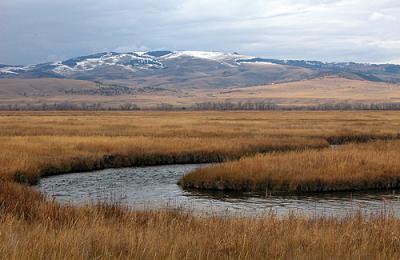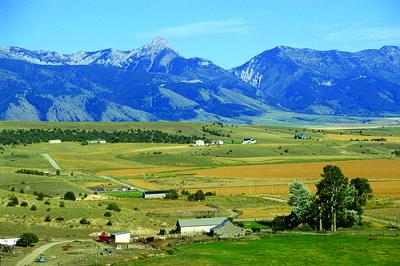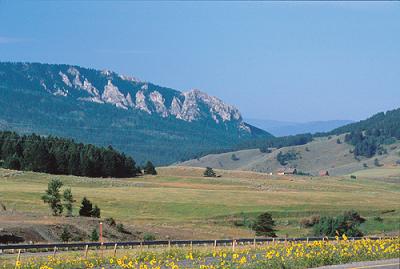Land Trusts and Vital Ground

Montana is a land of wide-open spaces, majestic mountain vistas, and calm stretches of wild streams. It is a state where fields of wheat still line rural highways, and the back road is the preferred route of travel. It is a state where a wandering soul can still get lost.
In some parts of Montana, it will always be this way. Many rural communities around the state are experiencing population decline and it is a trend that does not seem to be changing.
However, in other parts of the state, growth is the dominant theme. Counties, such as Missoula, Flathead, Lewis and Clark, Ravalli and Gallatin are struggling with ways to manage the influx of people. This growth has placed a growing pressure on large pieces of private land that often provide, not only vital open space, but crucial wildlife habitat.
These threatened lands are, in a large part, what defines our image of Montana and its agriculture heritage.
Enter the land trusts.
A land trust is a non-profit organization dedicated to preserving privately owned open land through a variety of tools, but mainly conservation easements. Montana is home to 15 land trusts. Some are specific to types of wildlife and their habitat, others are specific to regions or counties and still others work statewide or regionally.
In Montana these land trusts have conserved and protected nearly 1.5 million acres as of 2007. Protected, generally means that these open spaces won’t be developed. Some of these lands are farms and ranches, some are pieces of timbered land with critical wildlife habitat, and some are riparian areas crucial to water quality. Some of the protected land has components of all three.
Though land trusts have existed in Montana for nearly 30 years, confusion still remains about what they actually do.
One of the largest land trusts in the state is the Montana Land Reliance (www.mtlandreliance.org), which started in the late 1970s as a response to growth and development in the Bitterroot Valley. Just this year 700,000 more acres were added.
In the beginning Montana Land Reliance’s goal was to find ways to encourage young farmers and ranchers to stay on the land or even start their own operations, said Jay Erickson, managing director at MLR.
“We realized after a couple of years that land prices, even then, had gone up enough that it was too difficult to get into the agriculture business,” Erickson said.
Farmers and ranchers, young and old, were selling off pieces of land, not because they wanted to, but because they had to in order to keep their operations solvent.

In Montana and other states around the West, many working farmers and ranchers have everything they own sunk into their business. Their land is often considered their retirement. Many would love to just deed the land over to their children, but that’s difficult given the current tax structure. So to stay and realize some profit from it outside of the agriculture business, they needed another option.
In the early 1980s, MLR began focusing on conservation easements.
A conservation easement, or voluntary conservation agreement, is a way farmers and ranchers can protect their property from the pressures of development. An easement is a permanent constraint on the land. The specifics of it are unique to the land and the owner. But generally, they prohibit broad development. This restriction devalues the land, which means the landowner pays fewer taxes. Essentially, the land is appraised with development rights and then without them. The difference in the value of the two appraisals is the tax deductible contribution the landowner makes to the land trust that is servicing the easement.
In 2005, Congress also passed a new tax incentive for conservation easements. Under the new laws, qualified farmers and ranchers who place their ground under an easement can deduct up to 100 percent of their gross income for 15 years. This can be attractive to working ranchers and farmers who may be operating on land that’s worth millions in today’s market. The easement is voluntary. Easements can be structured to allow all traditional operations to continue on the land, such as farming, ranching, and timber harvesting. The easement doesn’t provide for public access unless that’s what the landowner wants.
The land trust that administers the conservation easement enters into a long-term relationship with the landowner. They are mandated by the government to do yearly visits to the land to make sure the conditions of the easement are being met. “If the document is carefully crafted, and these all have to be thoughtfully drafted, the working rancher isn’t aware that there’s a conservation easement on the property,” Erickson said.
Lost in this description of conservation easements is the importance land trusts put on relationships with landowners and the community.
The Vital Ground Foundation is a land trust based in Missoula (www.vitalground.org), whose focus in on protecting Grizzly Bear habitat. Their work in Montana has been centered in the Seeley-Swan Valley. There they seek to protect critical wildlife corridors between the Mission Mountains and the Bob Marshal Wilderness.
Jeff Bridges, actor, said for this article: “My wife, Susan, and I have grizzlies for neighbors at our Montana home. It’s a privilege, you know – kind of an endless gift – to live around all the animals that share the big bears’ range. You want to give something back in return. Vital Ground works one-on-one with landowners to help keep wild communities strong and healthy and moving through our lives – and our minds and hearts. Susan and I joined the organization at the very start. We provided extra support through some early, lean years, and we’re glad to have been part of their success.”
Most of this land in the Seeley-Swan Valley is timbered ground and riparian areas. These corridors are specifically important for grizzlies that migrate seasonally across the valley. The U.S. Fish and Wildlife Service have identified them as critical for grizzly bear recovery.
Because much of the valley bottom land in these corridors is private, said Kiffin Hope, development coordinator for Vital Ground, working effectively with landowners in these areas means building trust and establishing relationships. “It’s all about trust building,” Hope said.
Although the language of a conservation easement might sound official, land trusts look at the easement as a partnership with landowners. It’s vital to have the respect and trust of the landowners, and that means doing things right on each easement, he said.
“The very best advocate of a land trust is a landowner,” said Gary Wolfe, Vital Ground’s executive director.
The Seeley-Swan area isn’t the only place Vital Ground is building relationships and working at protecting grizzly bear habitat. They also focus on all of the grizzly recovery areas in the Northern Rockies ecosystem. Many of the pieces of land important to grizzlies and Vital Ground are small chunks that tend to be over looked. “Five years ago, we saw that there were particular pieces of property that were really important to grizzly bears, which were falling through the cracks,” Wolfe said.

But no matter where they work to protect habitat, building relationships with landowners, government agencies and local communities is the place to start, Wolfe said. Sometimes it takes a long time to build relationships between landowners and land trusts, said Erickson. That’s why the integrity of a land trust is important. Erickson pointed to a recent conservation easement MLR secured. Discussions with the landowner about protecting his land began 20 years ago.
“We’ve done easements in a lot of different valleys and kept our relationship with those easement holders strong and we can rely on them to refer projects to us,” he said.
Often the relationships begin outside the discussion of protecting a specific piece of land, said Grant Kier, director of the Bitter Root Land Trust in Hamilton (www.bitterrootlandtrust.org). Relationships begin by simply being present in the communities you’re involved in. It means letting people know your goals, who you are and what you’re trying to help them protect. Private land conservation is a community effort, he said.
“Our ability is to really establish strong relationships with specific people in the community and encourage a more of a neighborhood approach to conservation,” Kier said. “That’s the real value a small land trust can add to conservation, especially in a place like the Bitterroot.”
For Kier, it’s important that landowners look at the Bitter Root Land Trust as a resource to help them realize their vision for their farm or ranch.
Another tool many communities in Montana have to help protect lands are voter-approved, open land bonds. Recently voters in Missoula, Ravalli and Gallatin Counties have approved such bond measures. Gallatin County has passed two $10 million bonds one in 2000 and another in 2004.
Open lands money is used to pay the landowner for a portion of the conservation easement. The bond money is often used as matching funds for government grants, which allows it to go farther, protecting more land.
Ravalli County passed a $10 million open lands bond in 2006. For Kier this was a statement from the community that protecting the open lands in the Bitterroot Valley is an important priority.
“The responsible use of that bond money is really going to encourage more landowners to participate in conservation and foster greater community support for private land conservation as a means of enhancing the community,” he said.
The Gallatin County Land Trust had less than 10,000 acres of land protected by conservation easements before their first open lands bond passed in 2000. Now they have protected more then 27,000 acres.
And more projects are coming together, said Gallatin Valley Land Trust director, Stephen Johnson.
The projects include working to protect pieces of land in Bozeman Pass, east of Bozeman, that will protect critical wildlife habitat corridors for grizzly bears and elk, while providing better access to public lands.
They are also continuing work with Gallatin County to complete their ambitious trails project called “Main Street to the Mountains,” which will eventually provide trail connections from Bozeman to the surrounding public lands.
In addition Gallatin Valley Land Trust is still working diligently with landowners to protect agricultural land around the county, Johnson said.
The emphasis is always on working with landowners and local communities, Kier said. Land trusts have some of the tools farmers and ranchers need to protect their land, and communities need to protect vital pieces of habitat.
Communicating with landowners and communities about private land protection continues to be an important discussion around the growing regions of Montana.
“There’s a strong philosophical tie that land and legacy built into western culture,” Kier said. “And I think that’s a strong starting point for this kind of dialogue.”
~ Greg Lemon is a freelance writer who lives in Hamilton, Montana.
Leave a Comment Here
Leave a Comment Here